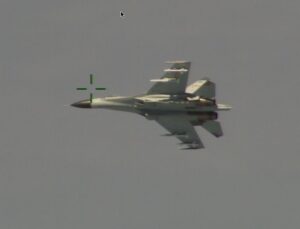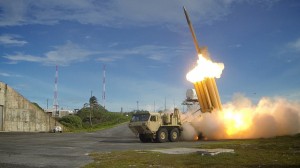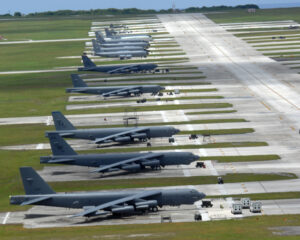Congress Must Kill Sequester To Pay For Pacific Pivot: CSIS
Posted on

China’s new airstrip built over Fiery Cross Reef in the South China Sea (CSIS image)
WASHINGTON: If the United States is serious about “rebalancing” to Asia, it needs to invest some serious cash. Strategic small change won’t deter China or reassure our increasingly anxious allies, says a new report from the influential Center for Strategic & International Studies. And that means the CSIS study’s sponsor — Congress — must get its act together and get rid of the Budget Control Act, aka sequester.
“During interviews with officials in foreign capitals, CSIS scholars consistently encountered concerns about long-term U.S. strategic choices…particularly with respect to China,” says the report. “Chinese and North Korean actions are routinely challenging the credibility of U.S. security commitments, and at the current rate of U.S. capability development, the balance of military power in the region is shifting against the United States.” In particular, the study says, there are “alarming” vulnerabilities in US satellites and “clear and worrying gaps” in electronic warfare.

A Chinese Navy J-11 fighter buzzes a US P-8 Poseidon surveillance plane off Hainan Island in August.
“Robust funding is needed,” the report says bluntly, “at a level above the president’s [2016] budget,” which itself was above the Budget Control Act caps. “The rebalance to the Asia-Pacific will therefore require the Congress to forge a long-term bipartisan agreement to fund defense at the higher levels for which there is a broad consensus.”
Some of CSIS’s recommendations are achievable for relatively small amounts. Formulating a coherent strategy for the rebalance, for example, is both long overdue and inexpensive, though the investment of intellectual capital would be high. Likewise, there’s not a big financial bill for creating a standing Joint Task Force for the Pacific, improving coordination with and among our allies — especially between mutually suspicious South Korea and Japan — or reforming the Air Tasking Order process used to conduct air campaigns.
But much of what CSIS calls for is expensive — and the study is skeptical of shortcuts. Consider missile defense, a top priority given that “analysts estimate China has several hundred land-attack cruise and ballistic missiles with the range to target U.S. bases in Japan or South Korea.” The North Korean arsenal is much smaller but — given the regime’s risk-taking — more likely to be used. And each incoming missile would take at least one interceptor to knock it down, with the interceptor necessarily having to be more advanced, more agile, and thus more expensive than the target.
The report particularly calls for South Korea being reinforced with both Army THAAD batteries and Navy Aegis Ashore firing SM-6 Standard Missiles. It also notes with approval work towards an extended range THAAD variant (THAAD-ER). But the single most crucial step, it says, would be better connecting US and allied missile defenses into a coherent whole, particularly convincing the Koreans and Japanese to work together.

THAAD missile launch.
What about high-tech alternatives such as lasers and electromagnetic railguns, which promise to knock down incoming missiles at a much lower cost per shot? While the CSIS study definitely encourages research, it doesn’t recommend counting on them. With an operational laser at least four years away and an operational railgun perhaps a decade out, the study says, “such technologies therefore seem unlikely to replace kinetic kill missiles and guns in the near or medium term.”
“Further, most of these technologies are for point defenses and cannot provide the long-range and area defenses that missiles can.” Translation: Even with lasers and railguns protecting key points, you’d still need missiles for wide-area coverage.
This no-silver-bullet attitude predominates in the whole report. The CSIS authors do endorse high-tech, high-cost new systems such as the Long-Range Strike Bomber for the Air Force, a stealthy UCLASS drone for Navy carriers, and a stealthy reconnaissance aircraft, either manned or not. But many of the innovations they favor are clever repackaging of existing technology, such as shore-based batteries of anti-ship missiles and the additional launch tubes for submarines known as the Virginia Payload Module.
Indeed, the report puts heavy emphasis on unglamorous essentials: strengthening logistics; building more air bases so our planes aren’t clustered in one place; buying the full planned complement of KC-46 aerial refueling tankers; and stockpiling more of the precision guided munitions we already have. The report also recommends rigorous training in scenarios where US satellites and networks are knocked out, as well as hardening those satellites and networks so that scenario doesn’t happen in real life.
Overall, the report clearly emphasizes preparing for great power war. True, there are sections endorsing the Army’s Regionally Aligned Forces outreach program and recommending improvements to humanitarian assistance and disaster relief (HADR). But they’re far outnumbered by the recommendations that have to do with preparing for high-intensity violence.

B-52s and other US aircraft lined up on the runway at Andersen Air Force Base on Guam.
When the report calls for more Navy warships in the region, for example, it makes clear it means big ships. “Adding more small combatants, such as Littoral Combat Ships, helps to address some presence requirements. Yet, a larger demonstration of U.S. will and capability is necessary for deterrence and reassurance purposes.” Specifically, the report calls for basing a second aircraft carrier and a second Amphibious Ready Group, with all their escorts, in Japan. It also argues for more submarines, an additional amphib, and ideally a newly-created Amphibious Readiness Group in Guam.
Those additional forces would be an unquestionable indication of US commitment to its currently uneasy allies. They’d also make a big hole in the federal budget — unless Congress cuts entitlements or raises taxes. That is the crucial domestic challenge that CSIS says must be solved before we can set things straight abroad.
Subscribe to our newsletter
Promotions, new products and sales. Directly to your inbox.
